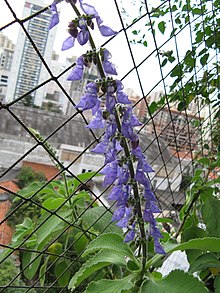Coleus barbatus
| Coleus barbatus | |
|---|---|

| |
| Scientific classification | |
| Kingdom: | Plantae |
| Clade: | Tracheophytes |
| Clade: | Angiosperms |
| Clade: | Eudicots |
| Clade: | Asterids |
| Order: | Lamiales |
| Family: | Lamiaceae |
| Genus: | Coleus |
| Species: | C. barbatus
|
| Binomial name | |
| Coleus barbatus (Andrews) Benth. ex G.Don
| |
| Synonyms[1] | |
| |
Coleus barbatus, also known by the synonyms Plectranthus barbatus and incorrectly Coleus forskalaei (and other spellings of this epithet), is a tropical perennial plant related to the typical coleus species. It produces forskolin, an extract useful for pharmaceutical preparations and research in cell biology.[2]
Name[]
The Brazilian name is boldo brasileiro (Portuguese pronunciation: [ˈbowdu bɾɐziˈlejɾu], or boldo gaúcho, as opposed to the Chilean true boldo), boldo-da-terra ([ˈbowdu dɐ ˈtɛʁɐ]), boldo-de-jardim ([ˈbowdu dʒi ʒaʁˈdʒĩ]) or tapete-de-Oxalá ([tɐˈpetʃi dʒ oʃaˈla]) (Oxalá's carpet, because of its velvety texture).
Taxonomy[]
Coleus barbatus was first described by Henry Cranke Andrews in 1810 as Plectranthus barbatus.[3] It was transferred to Coleus by Bentham in 1830.[4][5] Although Coleus was previously sunk into Plectranthus, the original binomial was revived in a major study of the subtribe Plectranthinae in 2019.[1]
There has been some confusion over the synonyms of this species. Plectranthus forskaolaei was first described by Vahl in 1790.[6] Vahl's name is illegitimate, because he treats it as a synonym of the earlier described Ocimum hadiense Forrsk. Vahl spelt the epithet as "Forskålaei",[6] referring to Pehr Forsskål, whose surname is also spelt "Forskål".[7] The International Code of Nomenclature for algae, fungi, and plants at Art. 60.7 specifies that "å" is to be replaced by "ao".[8]
Willdenow in 1800 referred to Vahl's name, but spelt the epithet "forskolaei".[9] (As of 31 July 2020, the International Plant Names Index had the spelling "forskalei".[10]) It was probably this species that Briquet referred to when transferring a species to Coleus as "C. forskohlii (Willd.) Briq.", introducing yet another spelling of the epithet; however, Briquet did not explicitly refer to a basionym. Briquet regarded "Coleus forskohlii" as synonymous with what he called "C. barbatus Benth.",[11] although Vahl had originally given a different synonymy. Paton et al. (2019) state that the epithets "forskalaei" or "forskohlii" are incorrectly applied to this species, instead treating binomials with these epithets as synonyms of , in accordance with Vahl's original use.[1]
Chemistry[]

Herbal teas made from Coleus barbatus contain rosmarinic acid and also flavonoid glucuronides and diterpenoids.[12][13] The chemical constituents of Plectranthus barbatus showed activities in vitro, such as acetylcholinesterase inhibition.[2][12][13]
Forskolin, which derives its name from the incorrect binomial name Coleus forskohlii, is a constituent of Plectranthus barbatus.[2][14]
Ayurveda[]
In Ayurvedic traditional medicine, Coleus has been used to treat heart diseases, spasmodic pain, painful urination and convulsions.[15]
References[]
- ^ Jump up to: a b c Paton, Alan J.; Mwanyambo, Montfort; Govaerts, Rafaël H.A.; Smitha, Kokkaraniyil; Suddee, Somran; Phillipson, Peter B.; Wilson, Trevor C.; Forster, Paul I. & Culham, Alastair (2019). "Nomenclatural changes in Coleus and Plectranthus (Lamiaceae): a tale of more than two genera". PhytoKeys (129): 1–158. doi:10.3897/phytokeys.129.34988. PMC 6717120. PMID 31523157.
- ^ Jump up to: a b c Alasbahi, R. H.; Melzig, M. F. (2010). "Plectranthus barbatus: A review of phytochemistry, ethnobotanical uses and pharmacology - Part 1". Planta Medica. 76 (7): 653–61. doi:10.1055/s-0029-1240898. PMID 20178070.
- ^ "Plectranthus barbatus Andrews". The International Plant Names Index. Retrieved 2020-07-31.
- ^ "Coleus barbatus (Andrews) Benth. ex G.Don". The International Plant Names Index. Retrieved 2020-07-31.
- ^ "Coleus barbatus Andrews", Plants of the World Online, Royal Botanic Gardens, Kew, retrieved 2020-07-31
- ^ Jump up to: a b Vahl, M. (1790), "Plectranthus Forskålaei", Symbolae Botanicae, p. 44, OCLC 475396338, retrieved 2020-07-31
- ^ "Forsskål, Pehr (1732-1763)". The International Plant Names Index. Retrieved 2020-07-31.
- ^ Turland, N.J.; et al., eds. (2018). "Art. 60". International Code of Nomenclature for algae, fungi, and plants (Shenzhen Code) adopted by the Nineteenth International Botanical Congress Shenzhen, China, July 2017 (electronic ed.). Glashütten: International Association for Plant Taxonomy. Retrieved 2020-07-31.
- ^ Willdenow, C.L. von (1800), "4. Plectranthus Forskolaei", Species Plantarum, 3 (4th ed.), p. 169, retrieved 2020-07-31
- ^ "Plectranthus forskalaei Willd". The International Plant Names Index. Retrieved 2020-07-31.
- ^ Briquet, J.I. (1897), "144. Coleus Lour.", Naturlichen Pflanzenfamilien, section IV, subsection 3a, p. 359, retrieved 2020-07-31
- ^ Jump up to: a b Falé, P.L., Borges, C., Madeira, P.J.A., Ascensão, L.; et al. (2009). "Rosmarinic acid, scutellarein 4′-methyl ether 7-O-glucuronide and (16S)-coleon E are the main compounds responsible for the antiacetylcholinesterase and antioxidant activity in herbal tea of Plectranthus barbatus ("falso boldo")". Food Chem. 114 (3): 798–805. doi:10.1016/j.foodchem.2008.10.015.CS1 maint: multiple names: authors list (link)
- ^ Jump up to: a b Porfírio S, Falé PL, Madeira PJ, Florêncio MH, Ascensão L, Serralheiro ML (2010). "Antiacetylcholinesterase and antioxidant activities of Plectranthus barbatus tea, after in vitro gastrointestinal metabolism". Food Chem. 122: 179–187. doi:10.1016/j.foodchem.2010.02.044.
- ^ Pizzorno, Joseph E.; Murray, Michael T. (2012). Textbook of Natural Medicine (4th ed.). Edinburgh: Churchill Livingstone. p. 686. ISBN 9781437723335.
- ^ Dubey MP, Srimal RC, Nityanand S, et al. (1981). "Pharmacological studies on coleonol, a hypotensive diterpene from Coleus forskohlii". J Ethnopharmacol. 3 (1): 1–13. doi:10.1016/0378-8741(81)90010-6. PMID 7193263.
External links[]
- Coleus
